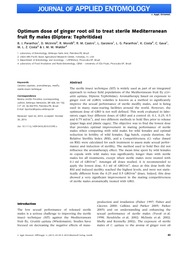Optimum dose of ginger root oil to treat sterile Mediterranean fruit fly males (Diptera: Tephritidae).
Optimum dose of ginger root oil to treat sterile Mediterranean fruit fly males (Diptera: Tephritidae).
Author(s): PARANHOS, B. A. J.; MCINNIS, D.; MORELLI, R.; CASTRO, R. M.; GARZIERA, L.; PARANHOS, L. G.; COSTA, K.; GAVA, C. A. T.; COSTA, M. L. Z.; WALDER, J. M. M.
Summary: The sterile insect technique (SIT) is widely used as part of an integrated approach to reduce field populations of the Mediterranean fruit fly (Ceratitis capitata, Diptera: Tephritidae). Aromatherapy based on exposure to ginger root oil (GRO) volatiles is known as a method to significantly improve the sexual performance of sterile medfly males, and is being used in many mass-rearing facilities around the world. However, the optimum dose of GRO is not well defined. This work evaluated in laboratory cages four different doses of GRO and a control (0, 0.1, 0.25, 0.5 and 0.75 ml/m3), and two different methods to hold flies prior to release (paper bags and plastic cages). The objective was to find the lowest dose that provides optimal improvement in mating performance of sterile males when competing with wild males for wild females and optimal reduction in fertility of wild females. Egg hatch, copula duration, the Relative Sterility Index (RSI), and a Competitiveness (C) value (based on RSI) were calculated for each treatment to assess male sexual performance and induction of sterility. The method used to hold flies did not influence the aromatherapy effect. The mean time spent by wild females in copula with wild males was significantly longer than with sterile males for all treatments, except when sterile males were treated with 0.1 ml of GRO/m3. Amongst all doses studied, it is recommended to apply the lowest dose, 0.1 ml of GRO/m3, since at this dose both the RSI and induced sterility reached the highest levels, and were not statistically different from the 0.25 and 0.5 GRO/m3 doses. Indeed, this dose showed a very significant improvement in the mating competitiveness of sterile males aromatically treated with GRO.
Publication year: 2013
Types of publication: Journal article
Unit: Embrapa Semi-arid Region
Keywords: Aromatherapy, Ceratitis Capitata, Entomologia, Fruit fly, Inseto, Inseto estéril, Mosca-das-frutas
Observation
Some of Embrapa's publications are published as ePub files. To read them, use or download one of the following free software options to your computer or mobile device. Android: Google Play Books; IOS: iBooks; Windows and Linux: Calibre.
Access other publications
Access the Agricultural Research Database (BDPA) to consult Embrapa's full library collection and records.
Visit Embrapa Bookstore to purchase books and other publications sold by Embrapa.

